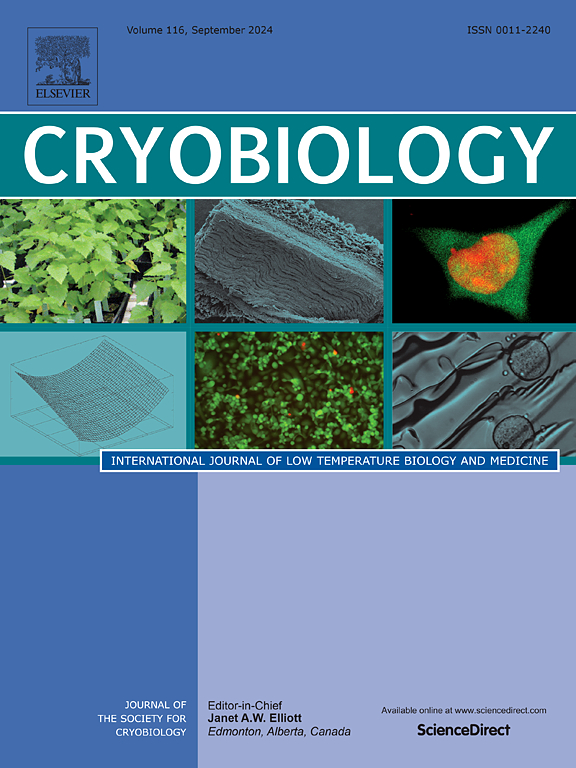纳米结晶二氧化铈可减少低温保存溶液中的再结晶。
IF 2.3
3区 生物学
Q2 BIOLOGY
引用次数: 0
摘要
纳米二氧化铈能够在各种应激因素的影响下,尤其是在低温条件下保护活细胞免受氧化应激。本研究探讨了含有二氧化铈纳米粒子(NPs)的水溶液中的相结构转变及其对低温保存过程的影响。研究采用差示扫描量热法和热力学分析方法分析了 CeO2 NPs 水悬浮液和含有 CeO2 NPs 的低温保护剂二甲基亚砜(Me2SO)水溶液中的相变。测试了不同浓度的 CeO2 NPs,以观察它们对结晶和熔化行为的影响。加入 CeO2 NPs 后,水中熔化和结晶的温度和热焓发生了显著变化。低浓度的 CeO2 NPs 会促进结晶,而较高浓度的 CeO2 NPs 则会抑制结晶,减少解冻过程中的过冷和再结晶。在 Me2SO 溶液中,CeO2 NPs 会提高玻璃化转变温度并影响再结晶过程,浓度越高,玻璃化越明显,再结晶越少。我们还研究了 CeO2 NPs 在 Ham's F12、胎牛血清和 Me2SO 混合冷冻保护介质中对相变影响的规律性,这可用于今后设计冷冻保存方案。在复合培养基中,CeO2 NPs 降低了陨变性并改变了共晶结晶模式,表明其具有潜在的低温保护作用。总之,CeO2 NPs可调节低温保护溶液的热物理性质,增强玻璃化和减少再结晶,从而提高低温保存效率。优化氮氧化物的浓度对于低温保存的实际应用至关重要。本文章由计算机程序翻译,如有差异,请以英文原文为准。
Nanocrystalline cerium dioxide reduces recrystallization in cryopreservation solutions
Nanocrystalline cerium dioxide is able to protect living cells from oxidative stress under the influence of various stress factors, in particular under the one of low temperatures. This study investigates the phase-structural transformations in aqueous solutions containing CeO2 nanoparticles (NPs) and their impact on the cryopreservation process. Differential scanning calorimetry and thermomechanical analysis were used to analyse the phase transitions in aqueous suspensions of CeO2 NPs and aqueous solutions of the cryoprotectant dimethyl sulfoxide (Me2SO) with CeO2 NPs. Various concentrations of CeO2 NPs were tested to observe their effects on the crystallization and melting behaviours. The addition of CeO2 NPs significantly altered the temperatures and enthalpies of melting and crystallization in water. Low concentrations of CeO2 NPs promoted crystallization, while higher concentrations inhibited it, reducing supercooling and recrystallization during thawing. In Me2SO solutions, CeO2 NPs raised the glass transition temperature and affected the recrystallization process, with higher concentrations leading to more pronounced vitrification and reduced recrystallization. We also investigated the regularities of the effect of CeO2 NPs on phase transitions in combined cryoprotective media with Ham's F12, fetal bovine serum and Me2SO, which can be used in future to design the cryopreservation protocols. In the complex media, CeO2 NPs decreased the metastability and altered eutectic crystallization patterns, indicating potential cryoprotective effects. In conclusion, CeO2 NPs modulate the thermophysical properties of cryoprotective solutions, enhancing vitrification and reducing recrystallization, which could improve cryopreservation efficiency. Optimizing NP concentrations is crucial for practical applications in cryopreservation.
求助全文
通过发布文献求助,成功后即可免费获取论文全文。
去求助
来源期刊

Cryobiology
生物-生理学
CiteScore
5.40
自引率
7.40%
发文量
71
审稿时长
56 days
期刊介绍:
Cryobiology: International Journal of Low Temperature Biology and Medicine publishes research articles on all aspects of low temperature biology and medicine.
Research Areas include:
• Cryoprotective additives and their pharmacological actions
• Cryosurgery
• Freeze-drying
• Freezing
• Frost hardiness in plants
• Hibernation
• Hypothermia
• Medical applications of reduced temperature
• Perfusion of organs
• All pertinent methodologies
Cryobiology is the official journal of the Society for Cryobiology.
 求助内容:
求助内容: 应助结果提醒方式:
应助结果提醒方式:


